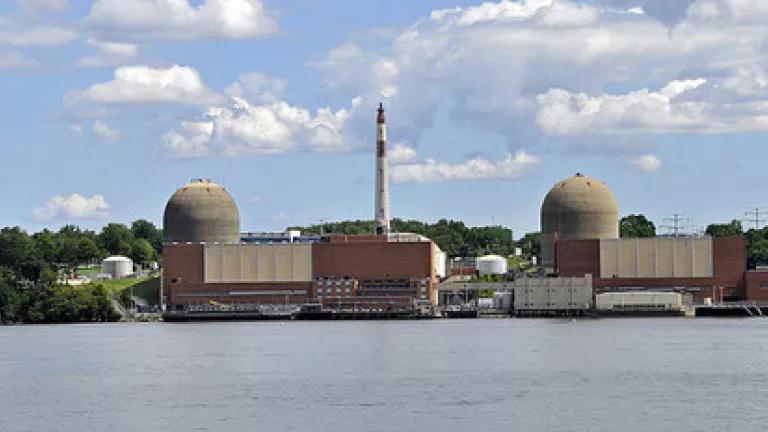There's No Need To Live with the Risks of Indian Point: New Yorkers Have Clean, Safe & Affordable Energy Alternatives

This blog post was co-authored by Matthew McKinzie.
Last Saturday evening, a transformer fire caused an explosion, fire and billowing smoke at the Indian Point nuclear power plant in Westchester County, New York. Indian Point's two aging nuclear reactors, built in the 1960s, are located just 24 miles north of New York City. One of the two Indian Point reactors is still offline and may not return to operation for several weeks. Thankfully, no one was hurt in this accident. It is too early to determine whether there will be any environmental or public health impacts or the extent of such impacts.
The incident was a reminder of the risks of operating the aging nuclear facility in the shadow of the nation's largest metropolitan area. And it was a reminder that these are risks we do not have to live with. Our region has sufficient clean, safe energy alternatives, like wind, solar and energy efficiency,that would allow Indian Point to shut down and keep the region's lights on.
The Indian Point nuclear power plant puts millions of New Yorkers at risk. We can shut it down and replace the power it supplies with clean, safe alternatives, such as wind and solar power and energy efficiency. (photo: Tony Fischer)
Transformer fires at nuclear power plants are not uncommon. Since 1972, there have been 85 transformer fires at U.S. nuclear power plants, according to a database maintained by Dave Lochbaum of the Union of Concerned Scientists, including another fire in April, 2007 at Indian Point. In 2009 the U.S. Nuclear Regulatory Commission noted these incidents are on the rise. The loss of the transformer briefly cut electricity to equipment inside the plant, but according to the Union of Concerned Scientists, another, working transformer at Indian Point kicked in to supply offsite power to reactor equipment. If that transformer had also failed, diesel generators are available at Indian Point to power emergency equipment to keep the reactor core cool. (Loss of both offsite power and diesel generators is what led to core meltdowns at Fukushima.)
Thankfully, what happened last weekend at Indian Point was not a core meltdown, which could have had devastating consequences. Nevertheless nuclear power plants are complex engineered systems in which unanticipated technical failures and accidents can occur. And among the roughly 100 reactors operating in the United States today, Indian Point is an outlier with respect to the very large nearby population that could be impacted by a severe nuclear accident. As Governor Cuomo put it: "This plant is the nuclear plant that is closest to the most densely populated area on the globe. If something goes wrong here, it can go very wrong for a lot of people."
In 2011 NRDC modeled the consequences of a severe nuclear accident at Indian Point in our report: "Nuclear Accident at Indian Point: Consequences and Costs." Key findings of this report compared the potential consequences of a nuclear accident to the severe nuclear accidents at Fukushima and in 1986 at Chernobyl in Ukraine. It found that:
- An accident at Indian Point on the scale of the Fukushima accident could require the sheltering or evacuation of as many as 5.6 million people; and
- A release of radiation on the scale of the Chernobyl accident would make Manhattan too radioactively contaminated to live in, if weather conditions were such that the city fell within the plume.
Quite simply, the risks from continuing to operate Indian Point are too high--especially when clean, safe reliable alternatives to Indian Point are readily available. According to a 2012 report by Synapse Energy Economics, commissioned by NRDC and Riverkeeper, the electricity capacity at Indian Point could be replaced by clean energy alternatives, including scaling up energy efficiency and demand response programs, and further deploying renewable energy resources such as solar, wind and offshore wind energy.
New York State has also identified energy alternatives to Indian Point. In 2012, the New York State Public Service Commission asked Con Edison and the New York Power Authority to develop contingency plans so resources are in place by 2016 to address power supply needs in the event of Indian Point's closure. In 2013, the Public Service Commission approved replacement plans that include three transmission projects as well as a set of energy efficiency and demand response programs designed to reduce downstate electricity use.
Added to the momentum, New York's groundbreaking Reforming the Energy Vision proceeding holds the potential to revolutionize New York State's electricity grid by a fundamental change in focus, leading to more reliance on distributed energy resources like solar and energy efficiency and much less on large central power stations like Indian Point. NRDC and many others are also pressing New York State to adopt an extended, expanded renewable energy policy that would require that 50 percent of New York's electricity come from renewable energy by 2025.
Currently, the Nuclear Regulatory Commission-- the federal agency charged with regulating nuclear power plants--is considering whether to re-license Indian Point to allow it to operate for another twenty years or whether it should close down. New York State has wisely opposed the relicensing of Indian Point, pointing to an array of risks and problems. A nuclear accident at Indian Point could happen as a result of natural causes like earthquakes or storms, from plant operator error, or from an act of terrorism, with the possibility that millions of people may be in the path of harmful radioactive fallout. There's just no need to live with this risk when alternatives are to Indian Point are available and affordable. Considering what Saturday's plume of smoke rising above Indian Point might have meant, closing Indian Point is a smart move.

